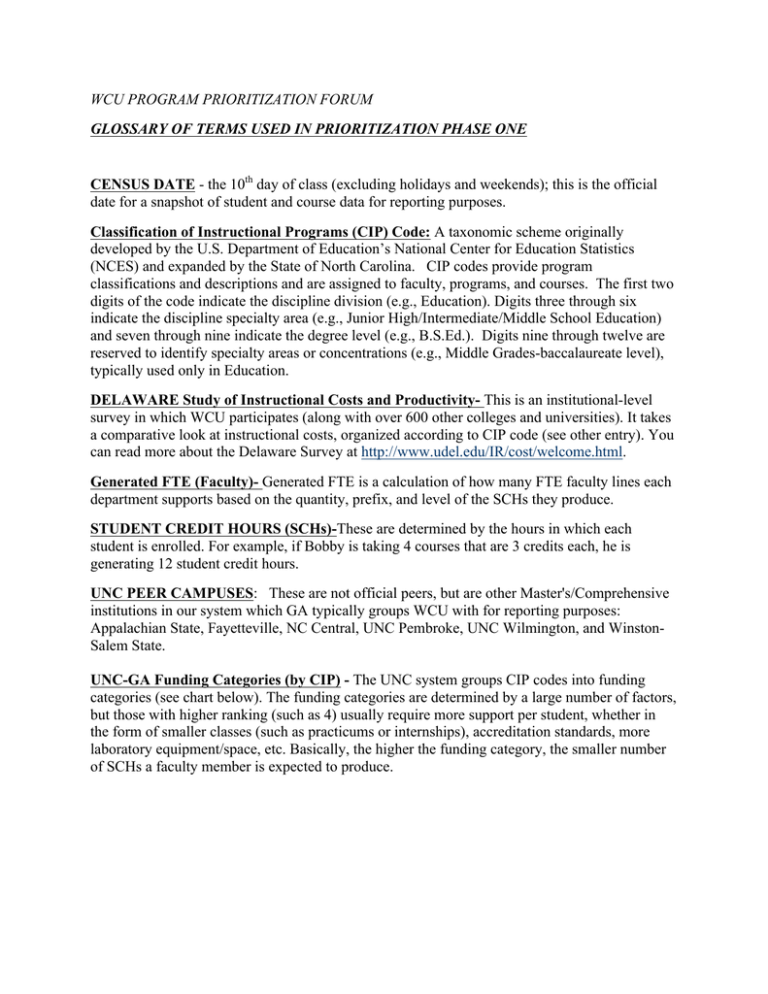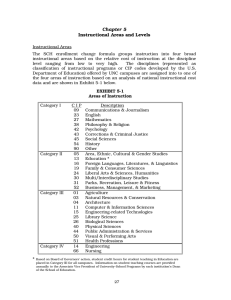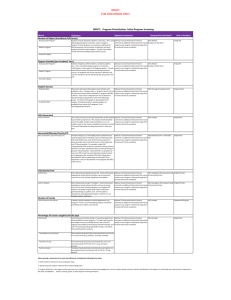Document 12234575
advertisement

WCU PROGRAM PRIORITIZATION FORUM GLOSSARY OF TERMS USED IN PRIORITIZATION PHASE ONE CENSUS DATE - the 10th day of class (excluding holidays and weekends); this is the official date for a snapshot of student and course data for reporting purposes. Classification of Instructional Programs (CIP) Code: A taxonomic scheme originally developed by the U.S. Department of Education’s National Center for Education Statistics (NCES) and expanded by the State of North Carolina. CIP codes provide program classifications and descriptions and are assigned to faculty, programs, and courses. The first two digits of the code indicate the discipline division (e.g., Education). Digits three through six indicate the discipline specialty area (e.g., Junior High/Intermediate/Middle School Education) and seven through nine indicate the degree level (e.g., B.S.Ed.). Digits nine through twelve are reserved to identify specialty areas or concentrations (e.g., Middle Grades-baccalaureate level), typically used only in Education. DELAWARE Study of Instructional Costs and Productivity- This is an institutional-level survey in which WCU participates (along with over 600 other colleges and universities). It takes a comparative look at instructional costs, organized according to CIP code (see other entry). You can read more about the Delaware Survey at http://www.udel.edu/IR/cost/welcome.html. Generated FTE (Faculty)- Generated FTE is a calculation of how many FTE faculty lines each department supports based on the quantity, prefix, and level of the SCHs they produce. STUDENT CREDIT HOURS (SCHs)-These are determined by the hours in which each student is enrolled. For example, if Bobby is taking 4 courses that are 3 credits each, he is generating 12 student credit hours. UNC PEER CAMPUSES: These are not official peers, but are other Master's/Comprehensive institutions in our system which GA typically groups WCU with for reporting purposes: Appalachian State, Fayetteville, NC Central, UNC Pembroke, UNC Wilmington, and WinstonSalem State. UNC-GA Funding Categories (by CIP) - The UNC system groups CIP codes into funding categories (see chart below). The funding categories are determined by a large number of factors, but those with higher ranking (such as 4) usually require more support per student, whether in the form of smaller classes (such as practicums or internships), accreditation standards, more laboratory equipment/space, etc. Basically, the higher the funding category, the smaller number of SCHs a faculty member is expected to produce. Weighted Formula Funding Program Category Category I Category II Category III Category IV UG 708.64 535.74 406.24 232.25 SCHs Per Instructional Position Masters 169.52 303.93 186.23 90.17 Doctoral 115.56 110.16 109.86 80.91 Instructional Areas and Levels The SCH enrollment change formula groups instruction into four broad instructional areas based on the relative cost of instruction at the discipline level ranging from low to very high. The disciplines (represented as classification of instructional programs or CIP codes developed by the U.S. Department of Education) offered by UNC campuses are assigned into to one of the four areas of instruction based on an analysis of national instructional cost data and are shown in below. Areas of Instruction / CIP Description Category I 09 Communications & Journalism 23 English 27 Mathematics 38 Philosophy & Religion 42 Psychology 43 Corrections & Criminal Justice 45 Social Sciences 54 History 90 Other Category II 05 Area, Ethnic, Cultural & Gender Studies 13 Education * 16 Foreign Languages, Literatures, & Linguistics 19 Family & Consumer Sciences 24 Liberal Arts & Sciences, Humanities 30 Multi/Interdisciplinary Studies 31 Parks, Recreation, Leisure & Fitness 52 Business, Management, & Marketing Category III 01 Agriculture 03 Natural Resources & Conservation 04 Architecture 11 Computer & Information Sciences 15 Engineering-related Technologies 25 Library Science 26 Biological Sciences 40 Physical Sciences 44 Public Administration & Services 50 Visual & Performing Arts 51 Health Professions Category IV 14 Engineering 66 Nursing * Based on Board of Governors’ action, student credit hours for student teaching in Education are placed in Category III for all campuses. Information on student teaching courses are provided annually to the Associate Vice President of University-School Programs by each institution’s Dean of the School of Education.




